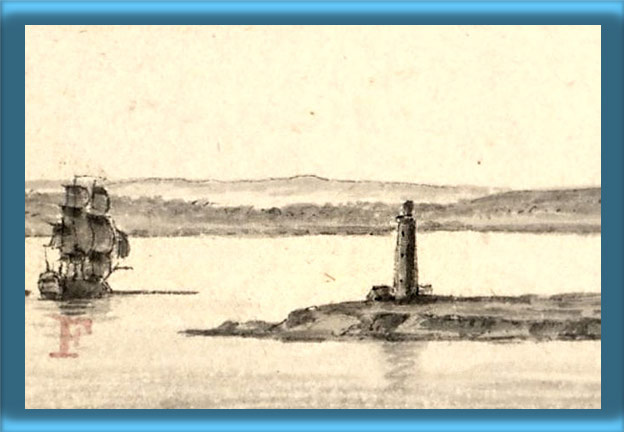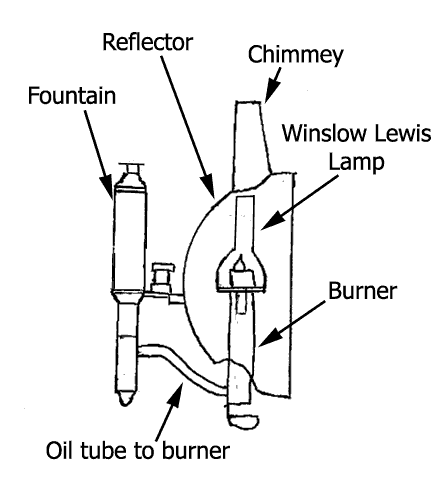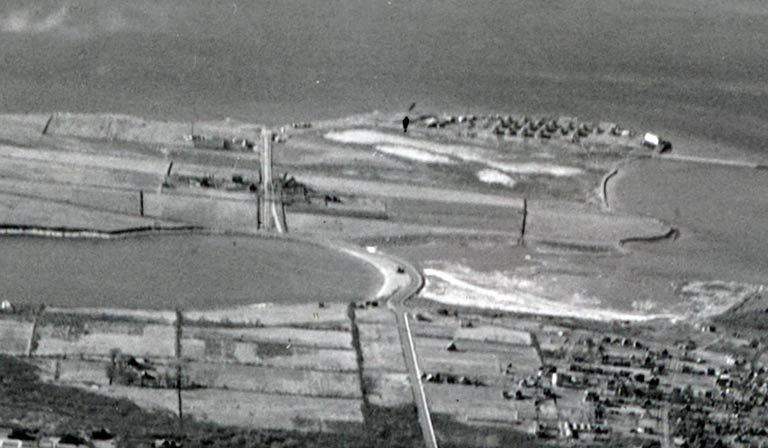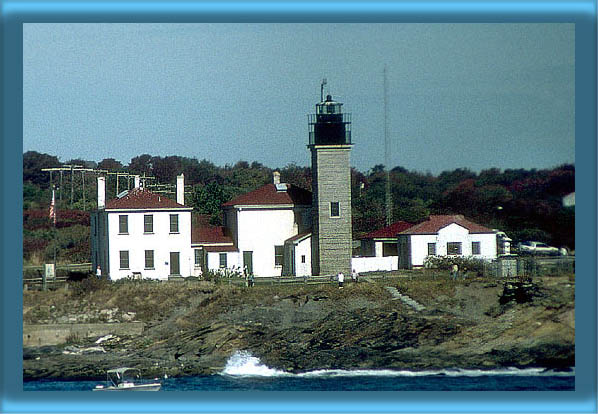"The diameter at the base is 24 feet, and at the top 13 feet, round. The height from the ground to the top cornice is 58 feet, round which is a gallery, and within stands the lanthorn [sic], which is about 11 feet high, and 8 feet diameter. The ground the lighthouse stands on is about 12 feet above the surface of the sea at high water,"
The lighthouse burned down on July 23, 1753. It would be several months before a new lighthouse could be built. There's a story that Abel Franklin, Beavertail lighthouse's first keeper, would wave some kind of warning light until a new lighthouse was rebuilt.
The second Beavertail Lighthouse was built in 1754. Peter Harrison also designed this lighthouse. The Rhode Island General Assembly wanted the new lighthouse built using brick and stones from Fort George on Goat Island. It's unknown if this was done. A report later described the lighthouse as being built using rubble stone.
| Beavertail Lighthouse 1778 |
|---|
 |
| Library of Congress, Prints & Photographs Division, G3774.N4S3 1780 .P51 |
The British took the illuminating apparatus and set fire to Beavertail lighthouse when they were forced out of Rhode Island in 1779. It was badly damaged. William Ellery, the first Lighthouse Superintendent for Rhode Island, in a letter to Albert Gallatin described the damage:
"The British in the Revolutionary War set fire to it and the flames so shocked the walls; especially about the windows, that, notwithstanding they are four feet thick at the bottom and three and a half feet thick at the top, our masons have not since been able to make them tight and secure against the impression of storms of rain."
After the war the lighthouse was repaired and relighted.
Life was hard for the early keeper at Beavertail Lighthouse. The keeper's house was very small. William Ellery described the house as "28 feet in length and 19 feet in breadth..." The house was located next to the ocean. During bad storms the sea spray would crash near the house. During one storm that lasted over twenty hours, sea spray repeatedly hit the house. The keeper and his family became so fearful that the house might be pushed off its foundation on the rocks below that they fled to a nearby house for safety.
On September 23, 1815 a very powerful hurricane hit Rhode Island. It destroyed twenty panes of the glass in the lantern and destroyed the keeper's house. A new keeper's dwelling was built in 1816.
In June 1851, during the lighthouse's annual inspection, an inspector found the lighthouse and keeper's house in bad shape and the keeper poorly trained. Demarius Weeden, the widow of Beavertail lighthouse keeper Robert Weeden, was appointed keeper in 1848. Her twenty year old son however was actually the one that was in charge of the light. In his report the inspector suggested that people didn't take her seriously because she was a woman.
In his report he gives two examples of this, In one case the captain that delivers the oil for the light only stays a few hours and leaves what he wants. In the other case, he states that she gives certificates for payment to people sent to repair the lighthouse, simply because they said they made the repair. He stated in the report "Does not know if she is competent to judge of the work ..."
Beavertail Lighthouse's fifteen lamps and reflectors were old and in poor condition. The inspector said "burner [sic] of different kinds, and bad; reflectors old, scratched, thin plating...". The lamps' fountains, an oil storage unit, leaked badly.
| Winslow Lewis' Lamps |
|---|
 |
| Created by R. Holmes |
The lighthouse was in terrible shape. It had not been repaired for over seven years. The mortar was falling out of the tower and the woodwork was rotted. The inspector called it "the worst built tower yet seen..."
In 1856, the current light, a granite tower and a brick keeper's dwelling, was built. A third order Fresnel lens was installed in the new tower. It was first lighted on October 20, 1856. A few days later the old light was blown up.
In 1898 a brick assistant keeper's dwelling was added to the lighthouse. It now houses the Beavertail Lighthouse Museum.
In June 1899, Beavertail Lighthouse's third order Fresnel lens was replaced with a fourth order Fresnel lens. The light characteristic was also changed. It was switched from fixed white to a group flashing white.
On September 21, 1938 one of the most powerful hurricanes in history hit Rhode Island. As the storm raged, a school bus carrying Beavertail Lighthouse's keeper Carl Chellis' son, Clayton, daughter, Marion, and six other children drove to the light. The bus was crossing a causeway at Mackerel Cove, when a storm surge hit. The bus was swamped. The school bus driver, Norman Caswell, feared they would all drown if they stayed on the bus. He and the children got off the bus and headed to high ground. Another storm surge hit and swept them away. Only Caswell and the lighthouse keeper's son survived. As the he was being pulled form the water, Caswell pleaded "Please let me die, I lost all those bunch of kids. Everything's gone. Please don't move me from the water. Let me die!"
| Causeway at Mackerel Cove |
|---|
 |
| United States. Navy. Naval District, 1st. Goat Island, Newport, RI-view from east 3000 ft. 22 Dec 1941. Web. 01 Oct 2020. |
The 1938 Hurricane tore up the ground in front of Beavertail Lighthouse and revealed the stone foundation of the first Beavertail light. It had been buried in the 1890s when a fog signal was built. In 2008 a radar survey of the foundation was done. It was believed that the first Beavertail Light was circular in shape. The survey determined that the lighthouse foundation was octagonal in shape. This means the first lighthouse may have been octagonal in shape not round as many believed.
The light was automated in 1972. In 1991, the fourth order Fresnel lens, installed in 1907, was replaced with a DCB-24 rotating beacon. It remained in service until 2017, when it failed. It was replaced by one of the three operational DCB-24's still in existence. The original DCB-24 is now on display in the oil storage building near the lighthouse. The second DCB-24 failed in April 2019. The US Coast Guard decided to replace it with a VBR-25. The Coast Guard Aid to Navigation Team in Bristol, Rhode Island installed the VBR-25 in June 2019.
In 2009 Beavertail Lighthouse, using grants form the Champlin Foundations and the Rhode island Historical Preservation and Heritage Commission, underwent a major restoration. The light tower was repaired. The interiors of the two keepers houses were repaired and repainted.
Panoramic View of Beavertail Point
In 2012, the 1749 Beavertail Lighthouse's foundation was in need of repair. In October 2012, after being unable to get grants to repair it, the Beavertail Lighthouse Museum Association board of directors committed $15,000 to stabilize the foundation. The contractor, David Lamontagne of Pascoag, Rhode Island, started work on October 9th. He not only stabilized the foundation, but did a complete restoration of it. The work was stopped during Hurricane Sandy. Stones collected for the restoration were washed away during Sandy. Beavertail Lighthouse Museum Association gave an additional $2,000 to replace the missing stones.
There was a small museum in the assistant keeper's dwelling for a number of years. Between 2012 and 2014 the museum was expanded into the oil storage building, the entire first floors and hallways of both keeper houses and the base of the granite light tower. Its centerpiece is the fourth order Fresnel lens used at the light. A small theater was also added to the museum. The museum is open from Memorial Day thru the middle of October.
In 2014 the fog signal building was restored and replica fog signal trumpets were added.
The U.S. General Services Administration issued a Notice of Availability for the Beavertail Lighthouse on May 7, 2021, because it was determined as excess to the needs of the United States Coast Guard. Under the National Historic Lighthouse Preservation Act of 2000, lighthouses are made available to federal agencies, state and local agencies, non-profit corporations, educational agencies or community development organizations for educational and park, recreational, cultural, or historic preservation purposes at no cost.
Any group that wants the lighthouse has 60 days from the issue of a Notice of Availability to submit a letter of interest to the General Services Administration. Every group that sends a letter, will receive an application from the United States Department of the Interior, National Park Service. The Coast Guard will announce a date for an inspection of the lighthouse. All the interested groups will get a chance to inspect the lighthouse. They have to submit an application within 90 days from the inspection.
The National Park Service will review the applications. This could take anywhere from 6 to 12 months. They will make a recommendation to the General Services Administration on who should receive the lighthouse. The General Services Administration will transfer ownership of the lighthouse to the selected group. If government groups or non-profit organizations don't want the lighthouse, it will be offered for sale to the public.
On January 12, 2022 Deb Ruggiero, the Rhode Island State Representative from Jamestown, introduced House Bill 7096. The bill authorizes the administrator of the Rhode Island division of motor vehicles to make available a special license plate for the Beavertail Lighthouse Museum Association.
These license plates are parts of the Rhode Island Charity License Plate program. They help non-profit organizations raise money. The license plates cost $42.50. The Beavertail Lighthouse Museum Association will receive $20.00 and the state gets $20.00 plus a $2.50 technology surcharge.
The Rhode Island House passed the bill on May 30, 2022. It was passed by The Rhode Island Senate on June 23, 2022 and signed into law on July 2, 2022. This was just the first step in getting the license plate produced. Six hundred people had to order Beavertail Lighthouse Museum Association plates before they would be produced.
| (Courtesy: R.I. Department of Revenue) |
The Beavertail Lighthouse Museum Association received the necessary 600 orders in 2023. A painting of Beavertail Lighthouse by Dong Mong, a Jamestown resident, was chosen to be on the license plate. The license plates were released in September 2023. They were given out on September 9 at the Beavertail Lighthouse Museum
In July 2023 U.S. Senator Jack Reed announced the ownership of Beavertail Lighthouse was being transferred from the federal government to the Rhode Island Department of Environmental Management (DEM). When the transfer is finalized the DEM will take over management of the lighthouse.
Evan LaCross, a public affairs officer at the DEM stated in an email that there would be no changes at the lighthouse following the transfer.
For information
on the Beavertail Lighthouse Museum Association, contact:
Beavertail Lighthouse Museum Association
P.O. Box 83
Jamestown, RI 02835
Beavertail Lighthouse Museum Association
P.O. Box 83
Jamestown, RI 02835
